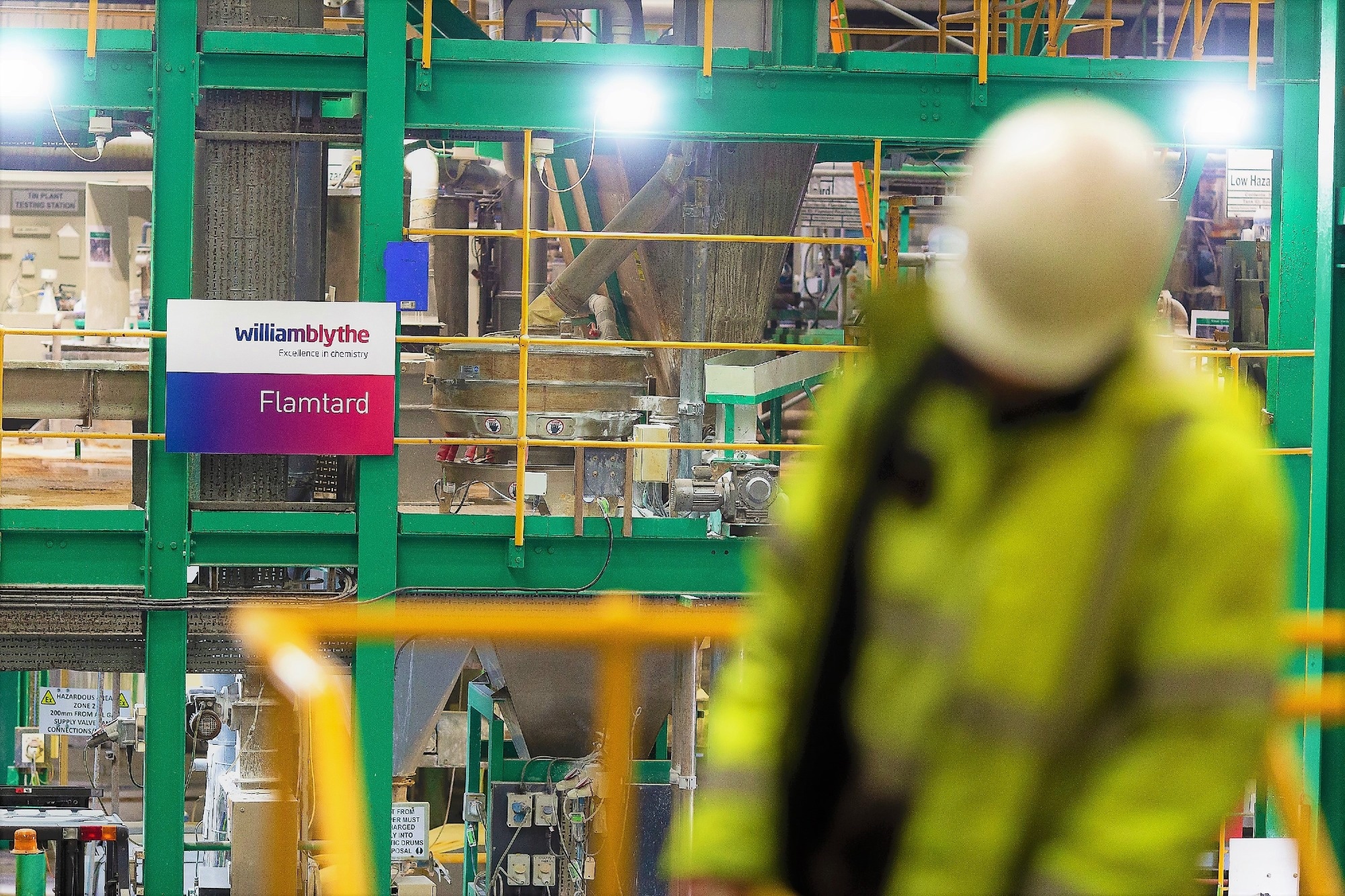Following the Advanced Materials Show 2022, AZoM spoke with Cameron Day from William Blythe about the broad scope of the company and its goals for the future.
Please can you introduce yourself and your professional background?
I've been at William Blythe for four-and-a-half years. I was initially an industrial placement student during my chemistry degree at the University of Leeds. William Blythe was offering a placement in inorganic chemistry, which wasn't common. My passion for the sciences comes from wanting to work on sustainable innovation, such as renewable energy and battery technology, and inorganic materials chemistry is key to this.
For this reason, William Blythe was a great fit. During my placement year I helped to develop the route to manufacture our graphene oxide product in 2015 and then came back to work full time for William Blythe in 2017. My professional career started with a secondment to the University of Manchester for two years looking at graphene materials for lithium-ion battery technology. Alongside this I’ve led the technical work on 3 Innovate UK Faraday Battery Challenge projects looking at a range of Li-ion battery chemistries, set up the battery research facility on our site, and have more recently moved into a business development role at William Blythe.
William Blythe provides chemical solutions to a broad range of industries in the 21st Century but also has a rich history spanning more than 170 years. Could you talk about the history of the company?
It's a very rich history. The company was started in 1845 by William Blythe, a Scottish chemist who undertook his chemistry degree at the University of Manchester prior to setting up our chemical manufacturing company in Accrington. He set it up here in order to support the local textile businesses that required chemicals & dyes for their processing. Over the years we’ve evolved to become more of a manufacturer of specialty inorganic chemicals, our portfolio now mainly consists of products of tin, copper, and iodine compounds that go into a wide range of markets. Our core capabilities include being able to tune the physical and chemical properties of these compounds to achieve the performance required by our customers.
One of our major growth areas is in the polymer additives market, where we offer antimony-free flame retardant synergist products, under our brand Flamtard. The key systems that this can be applied to are PVC-based compounds, where tin and zinc interact with the halide in both condensed and vapor phases to prevent fire and lower smoke. Another big growth area is in the gas absorbent market, where we sell a copper-based product, DURAGUARD S100, that is used by gas processing plants to remove hydrogen sulfide impurities from natural gas streams.

Image Credit: William Blythe
Alongside this, we're also working on a lot of interesting new technology, including things like energy storage materials, precursors for photovoltaics, and thermoelectric and thermal control materials. The two newest products that are part of our advanced materials portfolio are Luxacal, a near-infrared absorber, and graphene oxide, which we've scaled up recently to a 50-tonne/year capacity. This product has applicability in many areas including polymers, water purification, and energy storage. It’s also worth mentioning that we’re a wholly owned subsidiary of the Synthomer Group, a world-leading aqueous and emulsion polymer manufacturer, so it’s great to interact with different R&D divisions globally to develop new products combining both the inorganic materials expertise from William Blythe and polymer expertise within Synthomer.
William Blythe has expanded into advanced materials and battery applications as it adapts to current industrial requirements. What inspired this shift?
I think what's really special about William Blythe is that we've got a really rich history, but also, we have a manufacturing site that's been here for 170 years. It's handled a lot of dangerous chemicals, and we also have our own wastewater treatment plant on site. That means that we’ve got the regulatory permits to handle a lot of different chemistries and we've got the experience to scale it up in our engineering team.
We like to position ourselves as a safe pair of hands for scaling up materials, knowing that we can do it well and develop new processes that are safer and more sustainable than the processes used in the early stage of materials development that can take place in university labs.
How significant will next-gen battery technology be to green innovation over the next decade?
Over the next decade, I think we’ll just start to see some of these new technologies, such as silicon anodes and solid-state technology, pulling through to mainstream automotive, which will help to propel the adoption from 2030 onwards. At the moment the supply chains are being built and scale maximized so that electric vehicle costs can come down to match what the bulk of consumers can afford.

Image Credit: KyleMacPhotography
From the sustainability side, you might see a lot of articles out there at the moment about unsustainable mining practices that are taking place to enable battery technology. As a result, it's quite an interesting space where you've got a revolutionary new technology space that is going to help us reduce an enormous amount of CO2 going into the atmosphere through the adoption of electric vehicles, but the manufacturing of these and the current mining practices have a lot of challenges, meaning the current sustainability metrics are being questioned.
As regulations are enforced in the next few years to ensure more local supply chains, and as technology shifts to reduce the need for unethical mining, I think we’ll see these concerns lessen. A huge area for improvement with battery technology is recycling. If you can retrieve the important elements from spent batteries, so lithium, nickel, and cobalt, rather than constantly digging these out of the ground, it’ll make the whole process much more sustainable. This is another area where next-gen technology space could really add some value, say, with sodium-ion batteries in reducing the demand for strained elements like lithium.
A huge new area for development in this space is solid-state battery technology, which I think will be a key enabler to getting price parity with conventional petrol engines, and that's because you've taken away one of the electrodes in the battery. You are taking away one of the key materials which cost money, which is typically graphite. You are also taking weight out of the battery, which means you can drive further. It is going to be a big transition, but I think these new technologies are going to be an enabler for lower-cost models and more sustainable practices.
As well as a move toward next-gen technologies, what are some of the ways that William Blythe acts sustainably?
As a start, all the products that we make are via aqueous-based processing rather than using solvents or solid-state methods. This means we can omit the need for toxic/flammable solvents that can have disposal issues, and reduce the energy requirements needed for solid-state production methods. Another benefit of this is that we can get really precise control of crystal structures and physical properties through these methods, which again play a crucial role in lots of different sustainability technology areas.
How can we reduce the CO2 emissions from the site and reduce gas consumption? This is a huge challenge for places like the chemical industry, where the manufacturing plants have been there for many years and use existing processes that were built on using gas. Changing all this over is costly, but this is something we’ll be thinking about in the future. Synthomer, our parent company, has targets to get a 40% reduction in scope 1 and 2 emissions by 2030, a journey that we’ll be part of. We're also doing a lot of work in R&D and understanding how we can make products and processes more efficient, for example looking at how we can use the waste from one process as a raw material in other processes so that we've got a bit more circularity in what we do.
You were heavily involved in the development of graphene oxide at William Blythe. What are some of the applications that graphene oxide is relevant for?
This is a space that has received plenty of media attention over the past 10 years, but commercialization has been slow, expectedly for novel materials, and we’re just starting to see real commercial applications for this. Our involvement started in 2015 when we looked at developing a scalable technique to manufacture graphene oxide. We had a process and a product by 2016, which led to us setting up a web shop called GOgraphene to start selling this in small quantities to academic groups and industry.

Image Credit: William Blythe
This enabled us to engage with the market whilst demand was low, and understand the needs of our customers at the early stage of their application development. Over the past few years, we've worked on projects for water purification, for example understanding whether you could layer up your two-dimensional sheets of graphene and make a membrane for desalination, as well as research into energy storage, looking at how we could make novel lithium-ion battery materials more stable and cycle longer. Another area is polymers. There’s lots of activity looking at how graphene can be incorporated into different types of rubbers and polymers to impart greater tensile strength, flexibility, thermal conductivity, etc, so this is another key area of focus for us in this space.
Recently, you participated in the Advanced Materials Show at the NEC in Birmingham, UK. How significant are trade shows like this for encouraging conversations around new opportunities in industry?
We often like to go to application-specific trade shows, but we really like the Advanced Material Show because it can bring together whole value chains as a lot of people are interested in advanced materials. Maybe it's that buzzword that attracts people from across the sectors. We had lots of interesting conversations with academics, civil servants, venture capitalists, and like-minded materials companies. So it was great to just attract that really broad set of industry and academia that is interested in advanced materials and reconnect with people that we know in the sector.
What is your vision for the future of William Blythe? Are there any particular goals you are looking to achieve?
My vision, and I am sure this is shared by everyone, is to help the company maximize growth in the areas mentioned above, whilst expanding our advanced materials portfolio across a range of sustainable technologies, and through our knowledge and expertise in scaling up inorganic chemistry, help developers realize their sustainable technologies that make a difference. Accompanying this will be a good amount of marketing effort to help to solidify the William Blythe name as a responsible chemical manufacturer that has a passion for doing innovative, sustainable chemistry
Where can readers find out more?
Cameron Day's email: [email protected]
https://www.williamblythe.com/home/
About Cameron Day
 Cameron is a chemist by training with 6 years of industry experience. Since graduating in 2017 from the University of Leeds, he has dedicated his career to developing advanced materials & battery materials at William Blythe. Beginning with a secondment to the National Graphene Institute researching novel graphene anode materials for Li-ion batteries, he then took leadership of work that explored Li-ion cathode materials, Li-S technology, and sustainable battery manufacturing. He has sat on an expert panel for a government battery funding call, designed and installed the Synthomer Energy Storage Facility, and now works on business development across the William Blythe portfolio, with a particular focus on the advanced materials portfolio & Horizon 3 R&D.
Cameron is a chemist by training with 6 years of industry experience. Since graduating in 2017 from the University of Leeds, he has dedicated his career to developing advanced materials & battery materials at William Blythe. Beginning with a secondment to the National Graphene Institute researching novel graphene anode materials for Li-ion batteries, he then took leadership of work that explored Li-ion cathode materials, Li-S technology, and sustainable battery manufacturing. He has sat on an expert panel for a government battery funding call, designed and installed the Synthomer Energy Storage Facility, and now works on business development across the William Blythe portfolio, with a particular focus on the advanced materials portfolio & Horizon 3 R&D.
Disclaimer: The views expressed here are those of the interviewee and do not necessarily represent the views of AZoM.com Limited (T/A) AZoNetwork, the owner and operator of this website. This disclaimer forms part of the Terms and Conditions of use of this website.